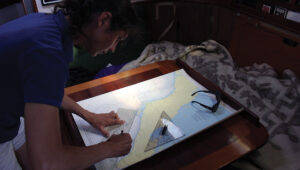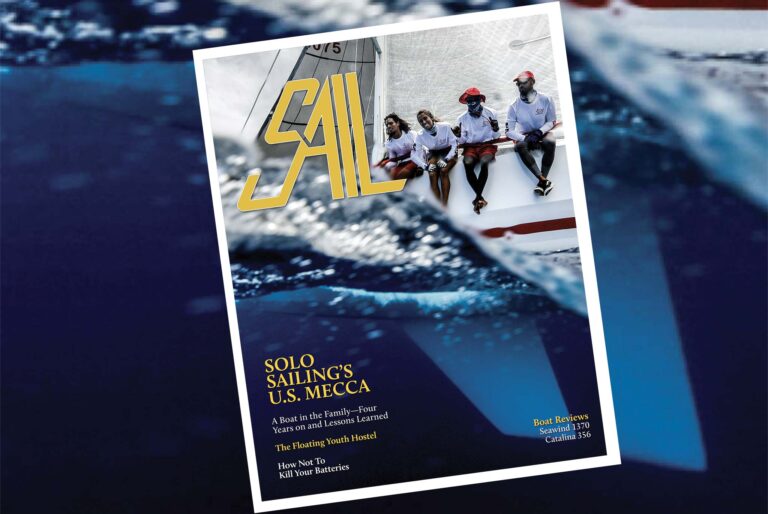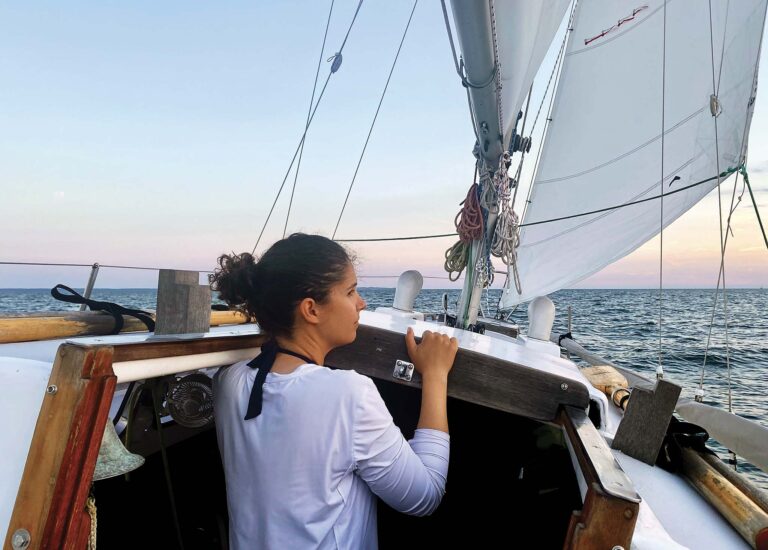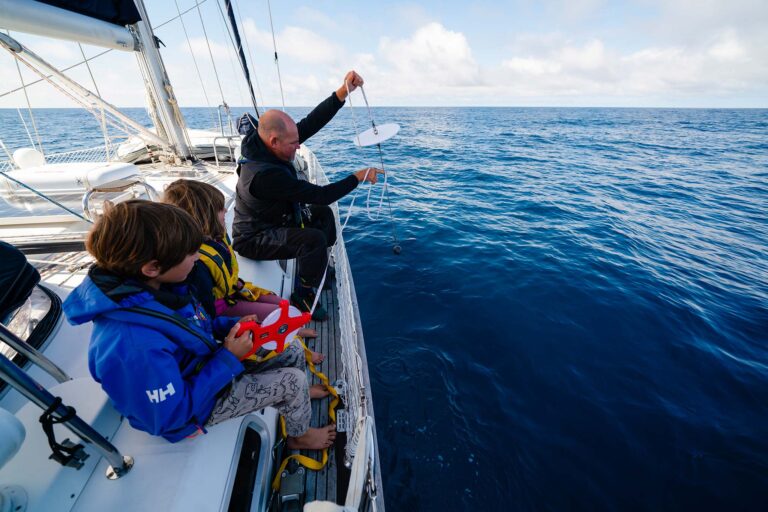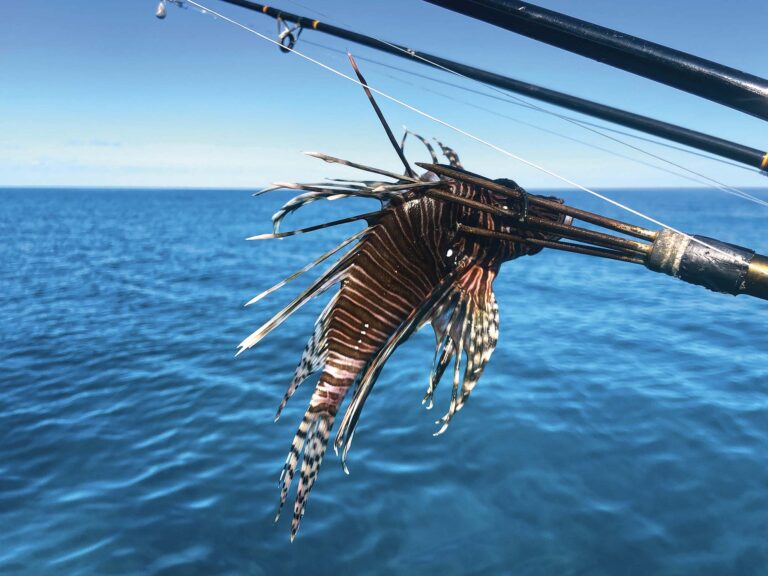No, it’s not about watching the leaves (both of them) change color
By Kimball Livingston
Somehow, calling it Santa Catalina Island just seems redundant when I talk about Catalina. Both of my recent trips were dolphin-blessed. Once we saw the blue whale that was all the buzz in the anchorages. Always, there was somebody ready to observe that millions upon millions of people inhabit the Los Angeles basin but haven’t discovered Catalina, “and that’s okay.”
In fact, we sailed with the dolphin, and our range to the 405 Freeway was less than the drive from Hollywood to Disneyland. Much less. It’s the old truth. Free your dock lines and you enter the otherworld.
Mind you, Catalina is no secret-type secret. Drop me in from outer space, and if I see herds of boats headed toward the island from Marina del Rey, Redondo Beach, San Pedro, Long Beach, Huntington Beach, Newport Harbor, I know it’s Saturday morning. If they’re headed back, it’s Sunday afternoon or the end of a long holiday. All across the horizon, there they are. That remains true, sort of, in the fall. But when the kids go back to school, the numbers go down in the anchorages. For those who make the scene, nothing’s wrong with this picture.
Even if the water here is not tropically warm, it’s swimmable. Bracingly refreshing, old chap. Clear and inviting. And rich with stories.
How many hundreds of times did Humphrey Bogart anchor Santana here?
What really happened to Natalie Wood?
What was it like to be Zane Gray, living in that hacienda above Avalon Harbor?
The Island
Catalina is 22 miles long and, at its widest, 8 miles across. Thanks to the vision of those who came before, most if the land is untouched or lightly touched. The Catalina Conservancy owns most of the island now, and 80-some percent of the fewer than 4,000 inhabitants live in the only town, Avalon. The so-called Casino (no gambling) was built there in 1929 with the first movie theater ever designed for talkies. That’s the Casino below, at the west end of the main harbor.
The Catalina Conservancy was the brainchild of the Wrigley family (chewing gum, Chicago Cubs), who owned most of the island in the 20th century and were determined to keep it special. Most transportation around Avalon is by golf cart. There are cars on Catalina, but the number is restricted; to bring in a new automobile can be a ten-year wait.
Catalina is served by ferries, most of them departing from San Pedro, near the cruiseship port. There also is ferry service from Marina del Rey, which is much handier to those flying through LAX. Ferries run to Avalon and to Two Harbors, aka The Isthmus. There are accommodations on the island, including luxury rooms in former Wrigley homes, for example. For more on ferries and accommodations, visit catalina.com. These boutique hotels are a useful backup for cruisers who have visitors dropping in, which is another way of saying that the best way to enjoy Catalina is on a boat.
Avalon is the “capital city” of the island. It has a kiddies’ beach, a selection of restaurants, and bars that roar in-season. You will find things quieter in the fall, but not exactly quiet. The harbor’s 400 moorings are first-come, first-served. A no-discharge rule is strictly enforced. Telephone the Avalon Harbor Master at 310.510.0535. Staff is on duty 24 hours a day.
All moorings at Catalina come with bow and stern tie-ups, and both must be used; moorings are closely packed. There is a science to picking up a mooring, and a bit of art, and it helps to know ahead of time how to do it. I found some tips online that you can see if you click here.
Well removed from Avalon, but still served by ferries, is Two Harbors. This place lives the way it sounds, with a harbor on each side of the island, separated by a short walk across. This is the narrowest part of Catalina and easy to spot from a distance as the missing notch in the mountainscape. “Going to town” at Two Harbors means going to the one store, or the one restaurant. There are developed facilities, however, so this is almost always the choice for groups and associations that want to stage a rendezvous. And this is a real community. Two Harbors is served by an honest-to-goodness one-room schoolhouse for grades K-5; students travel to Avalon for grades 6-12.
Then there are the places farther afield. The island has many semi-protected areas that are safe for anchoring in summertime and into the fall. There also are 21 coves with a total of 700 moorings, all managed by the Isthmus Harbor Department (310.510.4253). Many of these coves are lease-held by private clubs that do have reservations systems, so it is important to plan ahead if you want a mooring. Charges are based on vessel size and length of stay. Harbor managers circulate in small boats, and there is a garbage pickup service that makes the rounds and accepts bagged garbage for a fee.
There are hiking trails all over Catalina. Avalon and Two Harbors have dinghy docks (free, with a 72-hour limit), and many of the coves have places where a dinghy can land.
Snorkeling and diving are popular, and you don’t want to miss the opportunity. You will probably see leopard sharks, but don’t worry. They’re bottom feeders more interested in worms than in you. Although, I have to admit, when they’re bigger than 4 feet I’m not completely comfortable about getting up close and personal. You will certainly see scads of the small, bright-orange Garibaldi, which is said to be able to change sex. I will let you do your own research as to whether or not this is unique to California.
One item well worth having aboard at Catalina is this. Do you recognize it?
It’s a flopperstopper, valuable because the anchorages are usually a bit rolly, and at times they are very rolly. This flopperstopper is deployed from a Bristol-kept Cal 40, ever the collectable and very much at home at Catalina.

